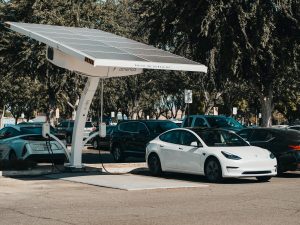With petrol prices sitting above $2.00 per litre for months this year more people are considering the value of switching to an electric vehicle (EV). For those of you that are considering, I can confidently say I wish I had made the switch sooner.
What stopped me from buying earlier?
I try to be an environmentally conscious consumer, and for many years I have been incrementally reducing my carbon footprint. Pouring petrol into my car after reading about the climate crisis or a fossil-fueled humanitarian crisis troubled me. However, seeing marketing that announced I could buy an electric vehicle from “as LITTLE as $50,000!!” made me think buying an EV was out of my price range. Given that the average new car spend in Australia is $40,729 (CanStar2021) and that electric vehicles cost significantly less to run and maintain, perhaps that’s not too bad a proposition. But for me, I needed a cheaper option to enter the EV market. Thankfully a review of the second-hand EV market showed that $15, 000 to $20, 000 would buy a car that met my needs.
Common questions I get about my electric car.
Are there charging stations near your house?
The closest EV fast-charging station to my house is 40 km away, although new charging stations are being opened all the time. Assuming you have access to a regular power point near where you park, you don’t need a charging station near your house. The ideal spot for an EV charging station is somewhere 75% of your battery range away. (For me that’s 90 km away, but if I owned a Tesla Model 3 that would be more like 300 km away.)
How do you charge your car, and how long does it take?
I almost exclusively charge my car when it’s parked in my garage at home, using a regular power point. This is a ‘slow’ way to charge, and it takes my car 10 hours to go from completely empty to fully charged. This suits me fine as I don’t often completely run my battery down. Most of the time I only consume a small percentage of my battery charge and then I plug my car in when the sun is shining and my rooftop solar is creating more electricity than my house is using. When out and about I use a 50 kW charger, this charger takes my car from completely flat to 100% in 30 minutes.
How much did your car cost?
The 2014 Nissan Leaf I purchased two years ago cost me $16, 800. Many people would baulk at my car’s 140 Km range, however data from the Australian Bureau of Statistics show that the average vehicle travelled 13,301 km, or 36.4 km per day, in Australia in 2020. (This statistic has remained relatively stable for the past five years.)
In an ideal world, my family would have a second EV with a 350-400 Km range for road tripping, but for now, most of our trips are easily covered with a little or no preparation.

My favourite things about EV driving
It’s quiet.
No more noisily vibrating down the highway straining to hear the kid’s requests from the backseat for me!
It’s cheap to run.
Combustion engines are clunky things, and in my experience the first couple of years of second-hand car ownership involves some trips to the mechanic. I have not spent a cent on car maintenance in two years.
I went from spending at least $60 a fortnight on petrol (back when petrol cost around $1.30 per litre), to mostly charging my car at home using excess production from my rooftop solar system. I do occasionally charge at EV charging stations, but they are highly economic, and I’ve spent around $50 on charging in two years.
It feels nice.
We all know that doing things that align with your values feels good. I didn’t fully appreciate the subtle niggle of displeasure I experienced every time I drove my petrol car, but I absolutely notice the joy of driving my trusty little EV.
 Community health benefits of EV driving
Community health benefits of EV driving
Reduced air pollution
In 2021 the Worlds Health Organisation (WHO) release its Air Quality Guidelines. In this report, the WHO announced that air pollution was a greater danger to health than previously thought. 7 million deaths per year are caused by air pollution, and our understanding of the health impacts of air pollution is growing.
The Organisation for Economic Co-operation and Development (OECD) estimates that approximately half of all air pollution in OECD countries is due to motor vehicles. Unlike with industrial or agricultural processes, motor vehicle pollution is pumped straight onto our streets where we live, exercise and breathe.
A 2019 report, Cleaner and Safer Roads for NSW, showed that vehicle emissions cause around 21,000 serious health impacts and 650 deaths annually in NSW alone. This means that air pollution from motor vehicles kills more people in NSW than motor vehicle accidents.
Reduced noise pollution
Noise pollution from combustion engine motor vehicles can impact nervous system health, impair concentration and impair sleep.
Contributing to climate solutions
Road transport accounts for 10% of global carbon emissions.
My car mostly gets powered by my home rooftop solar system. When needed, I use an electric vehicle charging network that is powered by 100% renewable energy.

Future opportunities, a car that saves or even makes you money!
In future, I will purchase a home charging system that will allow me to use my car’s battery as backup energy storage for my house. This ‘vehicle to grid’ or ‘bi-directional charging’ technology was approved for use in Australia earlier this year.
What does ‘vehicle to grid’ or ‘bi-directional charging’ mean?
Instead of only using a home charging station to charge my car’s battery, ‘vehicle to grid’ or ‘bi-directional charging’ technology would allow me to draw on the energy from my car’s battery to supply electricity, either to my house or the grid depending on my needs at the time.
This will mean that I don’t just have a car sitting in my garage, I have a potential home back-up energy storage system on wheels. The advantage of using the car
battery is that it’s much larger than a typical home storage battery. A Tesla Powerwall 2 is 13kWh of storage, where even the smallest EV batteries are more than twice that.
This gives car owners the opportunity to charge their car during the day from solar, then discharge the battery in the evening for cooking and watching TV. In our family that means once the bi-directional chargers are widely available for home use, we can charge fully during the day, pick the kids up from school, power the house all through the night, then take the kids to school in the morning, to plug in and fully charge again when the sun is shining.
Rebecca Smith NHSA Manager
